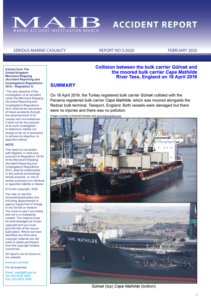The UK MAIB issued an investigation report on the collision between the bulk carrier ‘Gülnak’ and the moored bulk carrier ‘Cape Mathilde’ off England in April 2019. The investigation identified that control of Gülnak’s heading was lost towards the end of an intended turn to port in the main navigation channel. Despite the use of full starboard rudder and full speed ahead, the port turn was not fully arrested and subsequent application of full astern power was insufficient to avoid a collision with Cape Mathilde.
The incident
The Turkey registered bulk carrier Gülnak collided at a speed of 6.7 knots with the Panama registered bulk carrier Cape Mathilde, which was moored alongside the Redcar bulk terminal, Teesport, England.
Both vessels were damaged but there were no injuries and there was no pollution.
Gülnak’s bridge team, which included a pilot, lost control of the vessel’s heading towards the end of an intended turn to port in the main navigation channel.
Despite the use of full starboard rudder and full speed ahead, the port turn was not fully arrested and subsequent application of full astern power was insufficient to avoid a collision with Cape Mathilde.
The collision resulted in significant indentation and steelwork damage to Gülnak’s port bow and the shearing of the port anchor at the stock.
Cape Mathilde’s port side was damaged above the waterline in way of the No 1 and No 2 wing ballast tanks, with the lower section of Gülnak’s port anchor embedded in the forward part of No 1 ballast tank. The vessel’s mooring lines remained intact.
Probable causes
During the investigation, which was hindered because rudder angle and engine speed information was not recorded by Gülnak’s voyage data recorder, a number of factors that possibly contributed to the loss of control were analysed. These included:
- the actions of the bridge team,
- equipment malfunction,
- vessel manoeuvrability, and
- hydrodynamic effects.
However, no direct cause was identified.
Conclusions
- Control of Gülnak’s heading was lost when turning to port to follow the main channel towards the Redcar bulk terminal. Consequently, the turn could not be arrested and collision with Cape Mathilde could not be avoided.
- The factors contributing to the inability to fully arrest Gülnak’s turn are not readily apparent.
- Gülnak’s route was similar to that followed by other bulk carriers of similar size and, other than the vessel’s speed at the start of the turn to port being marginally faster compared to previous entries of similar sized bulk carriers, the pilot’s actions accorded with usual practice in the port.
- Although the minimum UKC experienced exceeded 8m, the possibility that Gülnak’s heading and directional stability were influenced to some degree by shallow water effects cannot be eliminated.
- The negligible tidal stream and the light winds would not have influenced Gülnak’s movement to any significant degree.
- The vessel’s steering and propulsion appeared to be operating correctly, but this could not be confirmed due to helm, rudder and engine speed information not being recorded on the VDR
Actions taken
The harbour authority has reviewed the navigational risk assessment and reinforced current practices that are intended to prevent similar accidents.
Recommendations
Gülnak’s owner, Gülnak Shipping Transport & Trading Inc., has been recommended to:
- highlight the accident to its masters and embarked pilots,
- closely monitor and validate the manoeuvring characteristics of the vessel, and
- ensure bridge equipment is operating correctly.
Explore more herebelow:































































